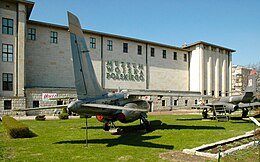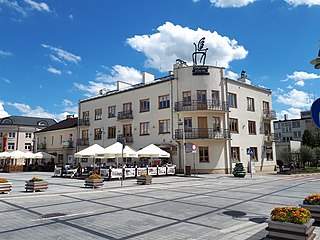
Piaseczno is a town in east-central Poland with 47,660 inhabitants. It is situated in the Masovian Voivodeship, within the Warsaw metropolitan area, just south of Warsaw, approximately 16 kilometres south of its center. It is a residential area and a suburb of Warsaw. It is the capital city of Piaseczno County.
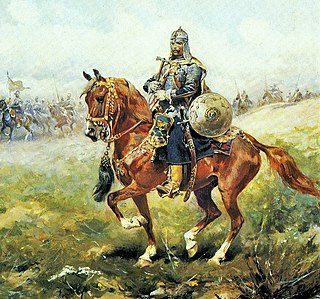
Armoured companion was a medium-cavalryman in 16th to 18th century Poland, named after their chainmail armor. These units were the second-most-important cavalry in the Polish-Lithuanian army, after the hussars.

Żoliborz is one of the northern districts of the city of Warsaw. It is located directly to the north of the City Centre, on the left bank of the Vistula river. It has approximately 50,000 inhabitants and is one of the smallest boroughs of Warsaw. Despite its small size, the district has many green areas and mostly consists of low-rise architecture. Historically an upscale neighborhood and home to Warsaw's intelligentsia prior to World War II, Żoliborz is the second most expensive residential district in Warsaw after Śródmieście.

Pistolet maszynowy wz. 39 Mors was a Polish submachine gun designed by Piotr Wilniewczyc and Jan Skrzypiński between 1936 and 1938. It was to have become the standard submachine gun of the Polish Army some time in the 1940s. However, its production was halted by the 1939 Invasion of Poland and World War II.

The hełm wz. 31 was the basic combat helmet of the Polish Army before the outbreak of World War II and during the Invasion of Poland. The helmet became the basic type of combat headgear for Polish military formations in the 1930s and during the early stages of World War II. It was also exported to Persia, Albania and Republican Spain. By September 1939 approximately 320,000 helmets were delivered to the Polish Army.
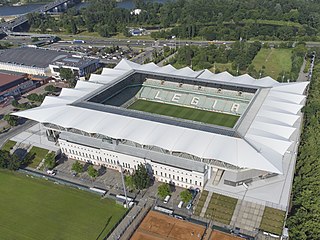
The Stadion Wojska Polskiego, officially named Stadion Miejski Legii Warszawa im. Marszałka Józefa Piłsudskiego is an all-seater, highest fourth category football-specific stadium located at 3 Łazienkowska Street in the Śródmieście district, Powiśle area, within the square of the streets: Łazienkowska, Czerniakowska, Kusocińskiego and Myśliwieck. It is the home ground of Legia Warsaw football club, who have been playing there since 9 August 1930.

The Field Cathedral of the Polish Army is the main garrison church of Warsaw and the representative cathedral of the entire Polish Army. In the past the church served a variety of communities and roles: it used to be the church of the Collegium Nobilium and in the 19th century was also turned into a Russian Orthodox church. Currently all major military religious feasts in Warsaw are held there.
As a result of the Soviet invasion of Poland in 1939, hundreds of thousands of Polish soldiers became prisoners of war. Many of them were executed; 22,000 Polish military personnel and civilians perished in the Katyn massacre alone.

Sadyba is a neighborhood in Mokotów district of Warsaw, Poland. It has an administrative status of osiedle within the city. Sadyba can be divided into Old Sadyba, mainly upper class housing, and New-Sadyba with modern retail stores and communist era high rise apartments. Old and New Sadyba can be divided roughly by Świętego Bonifacego street, just south of the Sadyba Best mall. Sadyba is known as the "Garden City" due to the large number of household and community gardens tended by the residents.
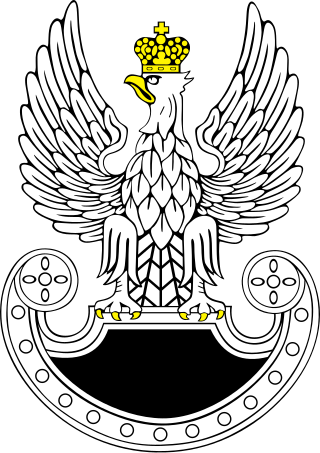
The Special Troops Command is the special forces command of the Polish Armed Forces. The command was formed in 2007 and is the fourth military branch of the SZ RP.

The K pattern flamethrower was a man-portable backpack flamethrower, produced in occupied Poland during World War II for the underground Home Army. These flamethrowers were used in the Warsaw Uprising in 1944.
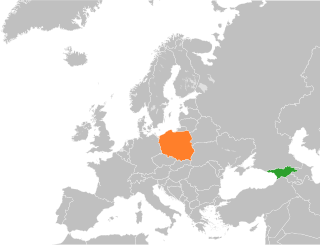
Georgia–Poland relations refers to foreign relations between Georgia and Poland. Both nations enjoy close and historically friendly relations, rooted in similar experiences, solidarity and shared struggles against foreign imperialism, especially that of Russia.

The Museum of Scouting is a museum in Warsaw, Poland, dedicated to the scout movement in Poland. Established in 2001, it contains displays relating to the history of Polish scouts and scouting. The goals of the museum are to collect and house items related to the history of Polish scouting and Scouting; disseminate information about the collections; evangelize the values of scouting and the educational principles of Scouting; and shape the values of those who come in contact with the collections.

Stefan Adam Garwatowski or Gerwatowski was a Polish painter. He was an alumnus of Academy of Fine Arts in Warsaw (1956).

Muzeum Broni Pancernej Centrum Szkolenia Wojsk Lądowych im. Hetmana Polnego Koronnego Stefana Czarnieckiego w Poznaniu, abbreviated Muzeum Broni Pancernej CSWL is a large collection of military vehicles, formerly located within Land Forces Training Center in Poznań, Poland.

Armed Forces Day, known also as the Feast of the Polish Armed Forces, is a national holiday celebrated annually on 15 August in Poland, commemorating the anniversary of the 1920 victory over Soviet Russia at the Battle of Warsaw during the Polish–Soviet War. Armed Forces Day is held in conjunction with the Day of the Assumption of the Virgin Mary, itself a separate public holiday. The event is marked by military parades, equipment reviews, showcases and remembrances by all branches of the Polish Armed Forces across the country. One of the most prominent events of the day is in the capital Warsaw, which hosts a large military parade through the city's center. Originally celebrated during the Second Republic, the holiday was barred by authorities during the communist era beginning in 1947, only to be revived again in 1992.

The Royal Guards, also known as the Royal Foot Guards, were the royal guard units of the military of the Polish–Lithuanian Commonwealth, which existed from 1569 to 1795. Charged with the protection of Poland-Lithuania's royal family, they formed either part of the Polish Crown Army or the Grand Ducal Lithuanian Army, and fought in numerous conflicts Poland-Lithuania participated in during the early modern period. All Royal Guards units ceased to exist after Poland-Lithuania was dissolved in 1795 as a result of the Third Partition of Poland.

The Representative Regiment of the Polish Armed Forces is an Honor Guard unit of the Polish Armed Forces, of regimental size. It performs public duties for the armed forces and the President of Poland throughout the Warsaw Capital Garrison region and acts as the main drill and ceremony unit for the military. It performs during the annual Armed Forces Day parade on Ujazdów Avenue, during state arrival ceremonies at the Presidential Palace and alongside other honor units at the National Independence Day ceremony. The regiment has been described by President Andrzej Duda as one of "the best-drilled and organised formations in the world".

Army Museum in Białystok is a military museum located in Bialystok, the capital of Podlaskie Voivodeship in north-eastern Poland. It is the largest of its kind in that region. First opened in 1968, since 1976 it has been operating as an independent museum unit with a macro-regional range. It is currently a self-governing cultural institution of the city of Białystok. As part of the Army Museum, until the end of 2016, there was a Branch, the Siberian Memorial Museum.

Ujazdów is a prominent neighbourhood situated in central Warsaw, the capital of Poland. It is the southernmost part of the Downtown (Śródmieście) district, next to Solec and historical Frascati. The main thoroughfare passing through the neighbourhood is Ujazdów Avenue; the Chancellery of the Prime Minister of Poland, the Foreign Ministry and the Belweder Palace are located on or in the vicinity of the street. Ujazdów is an affluent neighbourhood, with villas, palaces and parks comprising most of its area. The most notable landmarks are the Łazienki Park and Palace on the Isle, the 18th century summer residence of Poland's last monarch Stanisław II Augustus.
